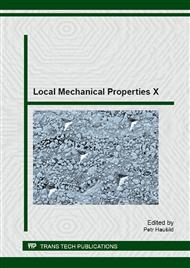[1]
C. Liu, Q. Bi, A. Matthews, EIS comparison on corrosion performance of PVD TiN and CrN coated mild steel in 0. 5 N NaCl aqueous solution, Corros. Sci. 43(2001) 1953-(1961).
DOI: 10.1016/s0010-938x(00)00188-8
Google Scholar
[2]
K. Baba, R. Hatata, Corrosion-resistant titanium nitride coatings formed on stainless steel by ion-beam-assisted deposition, Surf. Coat Technol. 66 (1994) 368-372.
DOI: 10.1016/0257-8972(94)90032-9
Google Scholar
[3]
M. A. M. Ibrahim, S. F. Korablov, M. Yoshimura, Corrosion of stainless steel coated with TiN, (TiAl)N and CrN in aqueous environments, Corros. Sci. 44 (2002) 815-828.
DOI: 10.1016/s0010-938x(01)00102-0
Google Scholar
[4]
R. D. Arnell, P. J. Kelly, J. W. Bradley, Recent developments in pulsed magnetron sputtering, Surf. Coat. Technol. 188/189 (2004) 158-163.
DOI: 10.1016/j.surfcoat.2004.08.010
Google Scholar
[5]
P. J. Kelly, O.A. Abu – Zeid, R.D. Arnell, J. Tong, The deposition of aluminium oxide coatings by reactive unbalanced magnetron sputtering, Surf. Coat. Technol. 86/87 (1996) 28-32.
DOI: 10.1016/s0257-8972(96)02997-0
Google Scholar
[6]
J. O´Brien, P. J. Kelly, Characterisation studies of the pulsed dual cathode magnetron sputtering process for oxide films, Surf. Coat. Technol. 142/144 (2001) 621-627.
DOI: 10.1016/s0257-8972(01)01058-1
Google Scholar
[7]
A. P. Ehisarian, P. E. Hovsepian, L. Hultman, U. Helmersson, Comparison of microstructure and mechanical properties of chromium nitride-based coatings deposited by high power impulse magnetron sputtering and by the combined steered cathodic arc/unbalanced magnetron technique, Thin Solid Films 457 (2004).
DOI: 10.1016/j.tsf.2003.11.113
Google Scholar
[8]
E. Foriés, R. Escobar Galindo, O. Sánchez, J.M. Albella, Growth of CrNx films by DC reactive magnetron sputtering at constant N2/Ar gas flow, Surf. Coat. Technol. 200 (2006) 6047-6053.
DOI: 10.1016/j.surfcoat.2005.09.020
Google Scholar
[9]
G. Wei, et. al., Nanotribology studies of Cr, Cr2N and CrN thin films using constant and ramped load nanoscratch techniques, Surf. Coat. Technol. 146/147 (2001) 357-362.
DOI: 10.1016/s0257-8972(01)01403-7
Google Scholar
[10]
J. Lin, et. al., Examination of the pulsing phenomena in pulsed-closed field unbalanced magnetron sputtering (P-CFUBMS) of Cr–Al–N thin films, Surf. Coat. Technol. 201 (2007) 4640-4652.
DOI: 10.1016/j.surfcoat.2006.10.010
Google Scholar
[11]
M. Novák, F. Lofaj, P. Hviščová, The influence of indentation conditions on nanohardness depth profiles of W-C based coatings: submitted to Key Engineering Materials in Local Mechanical Properties 2013 (2014).
DOI: 10.4028/www.scientific.net/kem.606.175
Google Scholar
[12]
EN ISO 14577-1: 2002, Metallic materials – Instrumented indentation test for hardness and materials parameters – Part 1, Test method.
DOI: 10.3403/02697842
Google Scholar
[13]
J. Lin, et. al., CrN/AlN superlattice coatings synthesized by pulsed closed field unbalanced magnetron sputtering with different CrN layer thicknesses, Thin Solid Films 517 (2009) 5798-5804.
DOI: 10.1016/j.tsf.2009.02.136
Google Scholar


